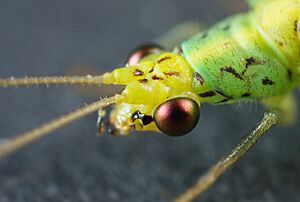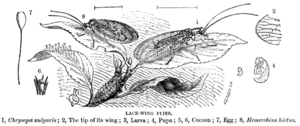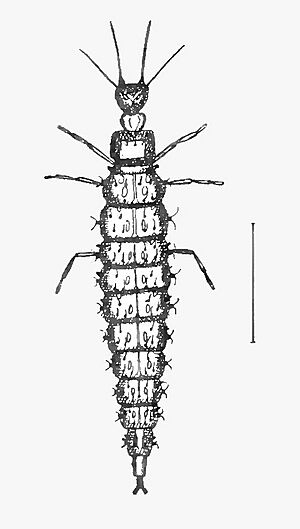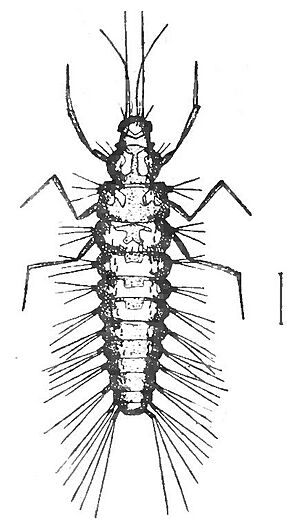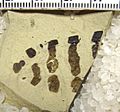Lacewing facts for kids
Quick facts for kids Lacewings |
|
|---|---|
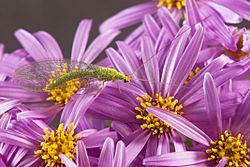 |
|
| Chrysopa sp. | |
| Scientific classification | |
| Kingdom: | |
| Phylum: | |
| Class: | |
| Order: | |
| Suborder: |
Hemerobiiformia
|
| Superfamily: |
Chrysopoidea
|
| Family: |
Chrysopidae
|
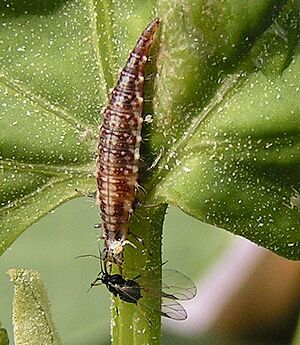
Lacewings, also known as 'Green lacewings', are fascinating insects. They belong to a big family called Chrysopidae, which is part of the order Neuroptera. There are between 1,300 and 2,000 different species of lacewings found all over the world! In places like America and Europe, you'll often see species from the Chrysopa and Chrysoperla groups.
Most lacewings, both adults and their young (called larvae), are active predators. This means they hunt and eat other insects. Because they are so good at eating pests, people often use them to help control harmful insects in gardens and farms. This is called biological control.
Many adult Chrysopa lacewings have a special way to protect themselves. They can release a really bad smell from glands near their heads. This smell helps to scare away things that might want to eat them.
Lacewings also have tiny 'ears' at the bottom of their front wings. These ears help them hear bats using echolocation (like sonar). When a lacewing hears a bat, it quickly folds its wings and drops to the ground. This sudden fall helps it escape from the bat.
They are also very clever at escaping spider webs. Because they are so light, they don't make the web shake much, so the spider might not even notice them. Instead of struggling, a lacewing will bite through the sticky strands that hold its legs and antennae. Once only its wings are stuck, it stops moving completely. Slowly, the lacewing slides out of the web. Tiny hairs on its wings stop the sticky spider silk from touching the wing surface.
The larvae of lacewings are very hungry! They attack other insects that are the right size, especially soft-bodied ones. This includes aphids, small caterpillars, other insect larvae, and insect eggs. When a lacewing larva touches a possible meal, it grabs it tightly. Their mouthparts (called maxillae) are hollow. They use these to inject a special digestive liquid into their prey. This liquid can dissolve the insides of an aphid in just 90 seconds!
Amazing Anatomy
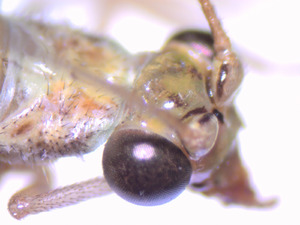
Lacewings are soft-bodied insects. They have large compound eyes on the sides of their heads. Some lacewings also have simple eyes called ocelli. Their mouthparts have strong mandibles, which are like jaws, perfect for chewing.
They have four wings, which are usually similar in size and shape. These wings have a common pattern of veins. Some lacewings have special sense organs on their wings. Others have tiny bristles or structures that help link their wings together when they fly.
Lacewing larvae are special predators. They have long mandibles that are perfect for piercing and sucking out the insides of their prey. The shape of a larva's body can change depending on what it eats. But generally, they have three pairs of legs on their chest area, and each leg ends with two claws. Their abdomen (the back part of their body) often has sticky pads on the last two segments.
Life Cycle and Ecology
The larvae of most lacewing families are predators. Many green lacewing (Chrysopidae) larvae eat aphids and other pest insects. Because of this, they are often used in biological control to protect crops. You can even buy them from special companies, but they are also very common in nature.
Larvae from different families have unique ways to hide. Some cover themselves with bits of dirt or even dead prey insects. This acts as camouflage. A great example is the ant lion larva. It buries itself completely out of sight and waits in "pits" in the soil to ambush its prey.
Some Ithonidae larvae eat plant roots. Larvae of Sisyridae live in water and eat freshwater sponges. A few mantispids are parasites that live inside spider egg sacs.
Like other insects that go through a complete change (called holometabolic insects), lacewings have a pupal stage. The pupa is usually inside a cocoon made of silk mixed with soil or other bits of debris. When it's time, the pupa uses its mandibles to cut its way out of the cocoon. It might even move around a bit before it changes into its adult form. This final change is called molting.
Adult lacewings in many groups are also predators. However, some adults don't eat at all, or they only drink nectar from flowers.
Lacewings and People
People have studied how to use lacewings for biological control to fight insect pests. It can be tricky to get and keep enough lacewings in farm fields.
Lacewings have also appeared in art for a very long time. You can find them in many art galleries, like the Lacewing Design Gallery and Studio.
Some people, like the New Guinea Highland people, believe that eating lacewings and other insects helps them stay strong and have lots of energy, even if they don't eat much meat.
Images for kids
-
One of the "butterflies of the Jurassic", Sophogramma lii (Kalligrammatidae)
-
Patterned wing of Paleogene (49 mya) fossil Palaeopsychops marringerae (Ithonidae)
See also
 In Spanish: Neuroptera para niños
In Spanish: Neuroptera para niños


